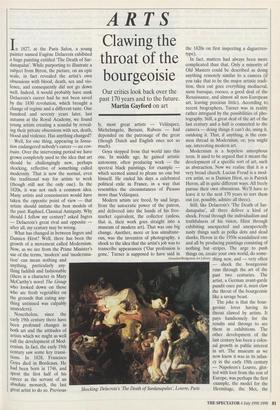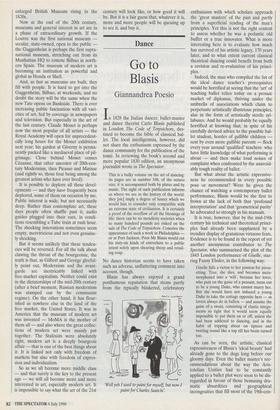ARTS
Clawing the throat of the bourgeoisie
Our critics look back over the past 170 years and to the future. Martin Gayford on art n 1827, at the Paris Salon, a young painter named Eugene Delacroix exhibited a huge painting entitled 'The Death of Sar- danapalus'. While purporting to illustrate a subject from Byron, the picture, on an epic scale, in fact revealed the artist's own obsessions with blood, death, sex and vio- lence, and consequently did not go down well. Indeed, it would probably have sunk Delacroix's career had he not been saved by the 1830 revolution, which brought a change of regime and a different taste. One hundred and seventy years later, last autumn at the Royal Academy, we found young artists creating a scandal by reveal- ing their private obsessions with sex, death, blood and violence. Has anything changed?
Well, for one thing, appearing in Sensa- tion endangered nobody's career — au con- traire. Over the intervening period we have grown completely used to the idea that art should be challengingly new, perhaps shocking, reflective of something called modernity. That is now the normal, even the traditional way for artists to work (though still not the only one). In the 1820s, it was not such a common idea. Many artists and connoisseurs would have taken the opposite point of view — that artists should imitate the best models of the past: Raphael, Classical Antiquity. Why should I follow my century? asked Ingres — Delacroix's great rival and opposite after all, my century may be wrong.
Nonetheless, since the early 19th century there have been profound changes in both art and the attitudes of artists which we might as well call the development of Mod- ernism. In fact, the early 19th century saw some key transi- tions. In 1828, Francisco Goya died in Bordeaux. He had been born in 1746, and spent the first half of his career as the servant of an absolute monarch, the last great artist to do so. Previous- Still, like Delacroix's 'The Death of Sar- danapalus', all three deliver a kind of market equivalent, the collector (unless, shock. Freud through the individualism and that is, their work goes straight into a truthfulness of his vision, Hirst through museum of modern art). That was one big exhibiting unexpected and unexpectedly change. Another, more or less simultane- nasty things such as polka dots and dead ous, was the invention of photography, a sharks; Heron in the 1950s scandalised one shock to the idea that the artist's job was to and all by producing paintings consisting of transcribe appearances (`Our profession is nothing but .stripes. The urge to push gone,' Turner is supposed to have said in things on, create your own world, do some- ly, most great artists — Velazquez, Michelangelo, Bernini, Rubens — had depended on the patronage of the great (though Dutch and English ones not so much).
Goya stepped from that world into this one. In middle age, he gained artistic autonomy, often producing work — the spectral black paintings, for example which seemed aimed to please no one but himself. He ended his days a celebrated political exile in France, in a way that resembles the circumstances of Picasso more than Velazquez.
Modern artists are freed, by and large, from the autocratic power of the patron, and delivered into the hands of his free- Shocking: Delacroix's 'The Death of Sardanapalus, Louvre, Paris Hermitage, the Met, the the 1820s on first inspecting a daguerreo- type).
In fact, matters had always been more complicated than that. Only a minority of Old Masters could be described as doing anything remotely similar to a camera (if you take that to be the major artistic tradi- tion, then out goes everything mediaeval, most baroque, rococo, a good deal of the Renaissance, and almost all non-European art, leaving precious little). According t, recent biographers, Turner was in reality rather intrigued by the possibilities of pho- tography. Still, a great deal of the art of the last century and a half is connected to the camera — doing things it can't do, using it, outdoing it. That, if anything, is the com- mon thread in Modernism, or, you might say, interesting modern art.
Modernism is a hopeless amorphous term. It used to be argued that it meant the development of a specific sort of art, such as abstraction. Now we realise that it is a very broad church. Lucian Freud is a mod- ern artist, so is Damien Hirst, so is Patrick Heron, all in quite different ways. All freely pursue their own obsessions. We'll have to leave it to the next 170 years to sort them out (or, possibly, admire all three).
Giraudon/Bridgeman Art Library thing new, and — very often — shock the bourgeoisie runs through the art of the past two centuries. The artist, a German avant-garde pundit once put it, must claw the throat of the bourgeoisie like a savage beast.
The joke is that the bour- geoisie loves having its throat clawed by artists. It pays handsomely for the results and throngs to see them in exhibitions. The other development of the last century has been a colos- sal growth in public interest in art. The museum as we now know it was in its infan- cy in the early 19th century — Napoleon's Louvre, glut- ted with loot from the rest of Europe, was perhaps the first example, the model for the enlarged British Museum rising in the 1820s.
Now at the end of the 20th century, museums and general interest in art are in a phase of extraordinary growth. If the Louvre was the first national museum secular, state-owned, open to the public the Guggenheim is perhaps the first supra- national museum, stretching out from its Manhattan HQ to remote Bilbao in north- ern Spain. The museum of modern art is becoming an institution as powerful and global as Honda or Shell.
And, as fast as museums are built, they fill with people. It is hard to get into the Guggenheim, Bilbao, at weekends, and no doubt the story will be the same when the new Tate opens on Bankside. There is ever increasing public fascination with all vari- eties of art, fed by coverage in newspapers and television. But especially in the art of the last century. Claude Monet is perhaps now the most popular of all artists — the Royal Academy will open for unprecedent- edly long hours for the Monet exhibition next year; his garden at Giverny is perma- nently packed like a mediaeval place of pil- grimage. Close behind Monet comes Cezanne, that other ancestor of 20th-cen- tury Modernism, then Picasso and Matisse (and rightly so, those four being among the greatest artists who have ever lived).
It is possible to deplore all these devel- opments — and they have frequently been deplored, some of them on occasion by me. Public interest is wide, but not necessarily deep. Rather than contemplate art, these days people often shuffle past it, audio guides plugged into their ears, in condi- tions resembling a Tube train at rush hour. The shocking innovations sometimes seem empty, meretricious and not even genuine- ly shocking.
But it seems unlikely that these tenden- cies will be reversed. For all the talk about clawing the throat of the bourgeoisie, the truth is that, as Gilbert and George gleeful- ly point out, Modernism and the avant- garde are inextricably linked with free-market capitalism. Neither could exist in the dictatorships of the mid-20th century (after a brief moment, Russian modernism was stamped out by the communist regime). On the other hand, it has flour- ished as nowhere else in the land of the free market, the United States. It was in America that the museum of modern art was invented — MoMA is the mother of them all — and also where the great collec- tions of modern art were mainly put together. The Stalinists were absolutely right, modern art is a deeply bourgeois affair — that is one of the best things about it. It is linked not only with freedom of markets but also with freedom of expres- sion and individualism.
So as we all become more middle class — and that surely is the key to the present age — we will all become more and more interested in art, especially modern art. It is impossible to say what the art of the 21st century will look like, or how good it will be. But it is a fair guess that, whatever it is, more and more people will be queuing up to see it, and buy it.















































































































 Previous page
Previous page